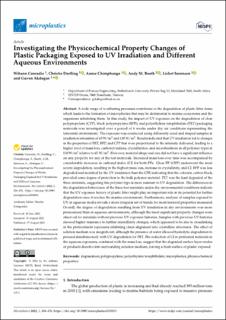| dc.contributor.author | Conradie, Wihann | |
| dc.contributor.author | Dorfling, Christie | |
| dc.contributor.author | Chimphango, Annie | |
| dc.contributor.author | Booth, Andy | |
| dc.contributor.author | Sørensen, Lisbet | |
| dc.contributor.author | Akdogan, Guven | |
| dc.date.accessioned | 2023-03-01T12:46:13Z | |
| dc.date.available | 2023-03-01T12:46:13Z | |
| dc.date.created | 2022-08-17T10:26:51Z | |
| dc.date.issued | 2022 | |
| dc.identifier.citation | Microplastics. 2022, 1 (3), 456-476. | en_US |
| dc.identifier.issn | 2673-8929 | |
| dc.identifier.uri | https://hdl.handle.net/11250/3055001 | |
| dc.description.abstract | A wide range of weathering processes contributes to the degradation of plastic litter items which leads to the formation of microplastics that may be detrimental to marine ecosystems and the organisms inhabiting them. In this study, the impact of UV exposure on the degradation of clear polypropylene (CPP), black polypropylene (BPP), and polyethylene terephthalate (PET) packaging materials was investigated over a period of 6 weeks under dry air conditions representing the terrestrial environment. The exposure was conducted using differently sized and shaped samples at irradiation intensities of 65 W/m2 and 130 W/m2. Results indicated that UV irradiation led to changes in the properties of PET, BPP, and CPP that were proportional to the intensity delivered, leading to a higher level of mass loss, carbonyl indices, crystallinities, and microhardness in all polymer types at 130 W/m2 relative to 65 W/m2. However, material shape and size did not have a significant influence on any property for any of the test materials. Increased mass loss over time was accompanied by considerable increases in carbonyl index (CI) for both PPs. Clear PP (CPP) underwent the most severe degradation, resulting in the highest mass loss, increase in crystallinity, and CI. BPP was less degraded and modified by the UV irradiation than the CPP, indicating that the colorant, carbon black, provided some degree of protection to the bulk polymer material. PET was the least degraded of the three materials, suggesting this polymer type is more resistant to UV degradation. The differences in the degradation behaviours of the three test materials under dry environmental conditions indicate that the UV exposure history of plastic litter might play an important role in its potential for further degradation once it reaches the marine environment. Furthermore, analysis of samples exposed to UV in aqueous media reveals a more irregular set of trends for most material properties measured. Overall, the degree of degradation resulting from UV irradiation in dry environments was more pronounced than in aqueous environments, although the most significant property changes were observed for materials without previous UV exposure histories. Samples with previous UV histories showed higher resistance to further crystallinity changes, which appeared to be due to crosslinking in the pretreatment exposures inhibiting chain alignment into crystalline structures. The effect of solution medium was insignificant, although the presence of water allowed hydrolytic degradation to proceed simultaneously with UV degradation for PET. The reduction of CI in pretreated materials in the aqueous exposures, combined with the mass loss, suggest that the degraded surface layer erodes or products dissolve into surrounding solution medium, leaving a fresh surface of plastic exposed. | en_US |
| dc.language.iso | eng | en_US |
| dc.publisher | MDPI | en_US |
| dc.rights | Navngivelse 4.0 Internasjonal | * |
| dc.rights.uri | http://creativecommons.org/licenses/by/4.0/deed.no | * |
| dc.subject | physicochemical properties | en_US |
| dc.subject | microplastics | en_US |
| dc.subject | polyethylene terephthalate | en_US |
| dc.subject | polypropylene | en_US |
| dc.subject | degradation | en_US |
| dc.title | Investigating the Physicochemical Property Changes of Plastic Packaging Exposed to UV Irradiation and Different Aqueous Environments | en_US |
| dc.title.alternative | Investigating the Physicochemical Property Changes of Plastic Packaging Exposed to UV Irradiation and Different Aqueous Environments | en_US |
| dc.type | Peer reviewed | en_US |
| dc.type | Journal article | en_US |
| dc.description.version | publishedVersion | en_US |
| dc.rights.holder | Copyright: © 2022 by the authors. Licensee MDPI, Basel, Switzerland. This article is an open access article distributed under the terms and conditions of the Creative Commons Attribution (CC BY) license (https:// creativecommons.org/licenses/by/ 4.0/). | en_US |
| dc.source.pagenumber | 456-476 | en_US |
| dc.source.volume | 1 | en_US |
| dc.source.journal | Microplastics | en_US |
| dc.source.issue | 3 | en_US |
| dc.identifier.doi | 10.3390/microplastics1030033 | |
| dc.identifier.cristin | 2043722 | |
| dc.relation.project | Norges forskningsråd: 287939 | en_US |
| cristin.ispublished | true | |
| cristin.fulltext | original | |
| cristin.qualitycode | 1 | |

